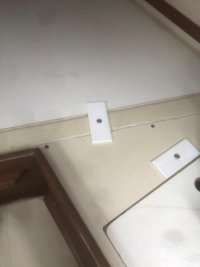In the spirit of "the time to take measures to assure the safety of the vessel is before leaving port", I have been planning to better secure the covers to the lockers under the seats and V-berth in the cabin. I actually saw that @Kalia had done this in a nice way, if he sees this thread, but post since any advice will probably be useful to others as well.
Any suggestions/opinions on how to do this in the simplest way would be appreciated. For instance,
- Can one just drill some holes, and add the fittings? Or (like on a cored deck) is it important to do that complex resin/fiberglass sealing of the hole, etc?
- How big a backing washer do you use (largest, just to spread load, or is it worth making a fitting of some sort to extend beyond size of a big washer)?
- Is there some other way people like?
Some of my larger under-seat lockers have those sliding door-latches on them, but they are a bit of a pain, and their backing -- just screws -- does not seem that robust given that the use case for this is a rollover with everything in the locker thrown up against the top cover. I was thinking of replacing those too with whatever the new system is for the others.
Many thanks!
PS: image of possibility attached.
Any suggestions/opinions on how to do this in the simplest way would be appreciated. For instance,
- Can one just drill some holes, and add the fittings? Or (like on a cored deck) is it important to do that complex resin/fiberglass sealing of the hole, etc?
- How big a backing washer do you use (largest, just to spread load, or is it worth making a fitting of some sort to extend beyond size of a big washer)?
- Is there some other way people like?
Some of my larger under-seat lockers have those sliding door-latches on them, but they are a bit of a pain, and their backing -- just screws -- does not seem that robust given that the use case for this is a rollover with everything in the locker thrown up against the top cover. I was thinking of replacing those too with whatever the new system is for the others.
Many thanks!
PS: image of possibility attached.

